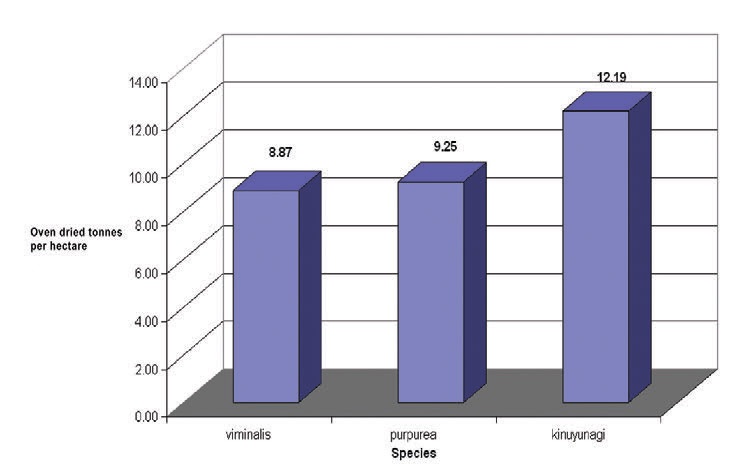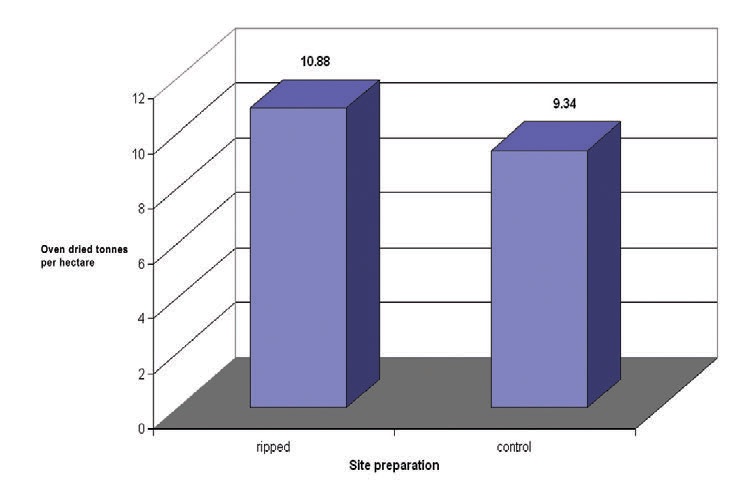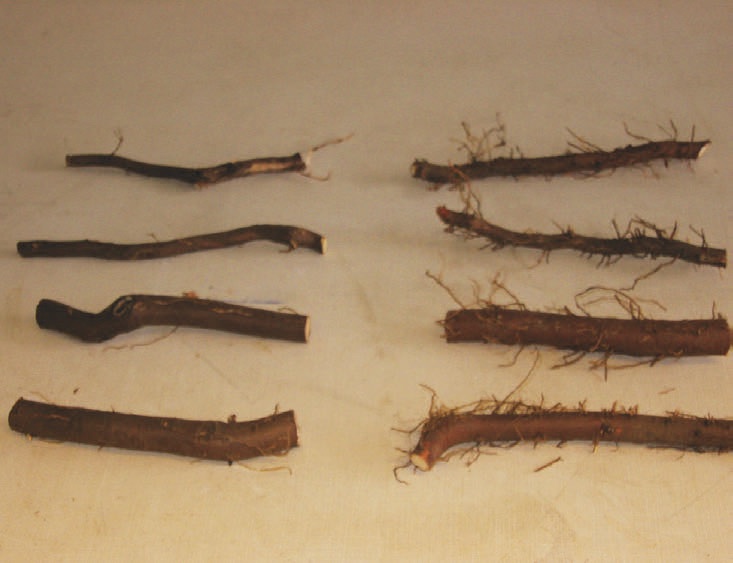Energy farming with willow near Taupo
Ian McIvor, Ian Nicholas and Kevin Snowdon, New Zealand Tree Grower February 2009.
The end of cheap oil now is a reality and there is growing evidence of the connection between climate change and carbon emissions’, wrote David Wright, chairman of the New Zealand Clean Energy Centre. He added that today the challenge is how to satisfy our insatiable demand for energy while balancing its effect on global warming and food production. An additional challenge is the balance between protection of our iconic lake districts and the rights of agricultural businesses to grow and prosper. Government intervention is inevitable and new ways must be found for agriculture to prosper in a low-nitrogen environment.
Energy farming
A possible answer to many of the problems mentioned above lies in energy farming. Growing short-rotation coppiceable crops on marginal land less suitable for stock production means that farmers can mitigate nitrogen runoff and substitute carbon neutral fuel for fossil fuels. They can also make an important contribution to New Zealand’s reputation as a clean, green, innovative country. Energy crops will increase in demand and price proportionately to the cost, availability and acceptability of conventional fuels.
Cultivation of willow for biomass is a new venture for New Zealand. However there is considerable experience in the cultivation, management and harvesting of coppiced willow. Coppicing is the process of cutting trees down and allowing the stumps to regenerate for a number of years, usually up to 25 years, and then harvesting the resulting stems.
Coppicing
Coppicing makes use of the natural regeneration properties of many tree species, including willow, poplar, oak and eucalyptus. When you cut such trees down they will regenerate from the cut stump, producing many new shoots rather than a single main stem. Regrowth can be exceedingly rapid, with new shoots growing as much as five centimetres a day. Oak stems can exceed two metres growth in a season, while willow may grow to almost four metres in the first summer.
The word coppice is derived from the French couper which means to cut. The cut tree stump is known as a stool and the shoots, depending on their harvested size, as rods, poles or logs. The shoots are harvested on a rotational cycle. This means that they are left to grow for a certain number of years and are then cut, with the whole process starting again.
Testing the concept
To test the energy farming concept, a MAF Sustainable Farming Funded project was developed in the Lake Taupo District in 2005. An article on short rotation coppice willow was published in the Tree Grower in November 2007 issue. In that article the MAF project was introduced with some information on the willow species being trialled and the growth in shoot length and number at the end of the first growing season. The project continued for the next two growing seasons and finished in June 2008.
Ideally the first willow coppice rotation is four years, with stools cut back after the first year to encourage multiplication of stems on the stool. This is followed by three years of biomass growth before the first commercial harvest. Thereafter the rotation operates on a three year cycle.
Analysing the data
The final harvesting was done in May 2008. Harvesting was done manually to trace individual plot data although mechanical harvesting would be the normal approach for commercial plantations. The total fresh weight of each plot of 40 stools was harvested and weighed. Then a representative sub-sample was oven dried and the dry weight scaled to tonnes per hectare at a planting density of 12,000 stools per hectare.
The data was analysed according to the initial variables being tested. These were −
- The length of the cutting at either 20, 25 or 33 centimetres
- The species, with only the three superior species being used for this article
- The ground preparation as either ripped or not ripped.
Variable weed control was also evaluated in the trial but the results are not included here.
Of the three superior biomass producing willow species Kinuyanagi, Salix schwerinii, was the highest biomass producer. A longer cutting length yielded a higher biomass, as did ground preparation by ripping, and is shown in the graphs.
The longer cutting length provided a greater surface area over which root initiation could occur, likely resulting in greater root biomass although this was not measured against initial cutting length. Likewise ripping enables easier penetration of roots into the surrounding soil and more expansive sourcing of water and nutrients resulting in greater biomass production in the first cycle.
Those benefits may not extend to subsequent short rotation coppice cycles but are considered important in getting rapid initial establishment of the plantation.



Wood density
Wood densities after three years were at the higher end for willow and coincided with the low range for radiata pine. Willow is generally considered to have a density around 420 kg per cubic metre. The higher densities in the third year coincided with the very dry summer.
This correlation is very useful since higher density wood produces better biochar, around which there is a great deal of interest because of its capacity to sequester carbon in the soil. It may be possible to manage density depending on the end use of the biomass.
| Willow species | Year of experiment | Basic density kg/m3 |
|---|---|---|
| Viminalis | 1 | 384 |
| 2 | 404 | |
| 3 | 468 | |
| Kinuyanagi | 1 | 390 |
| 2 | 420 | |
| 3 | 449 | |
| Purpurea | 3 | 404 |
Weed control is essential when the cuttings are getting established and water is at a premium,and when the second year growth is getting under way following cutting back on the first cycle. Drought severely reduced growth of the crop in the 2007-08 season, particularly for stools where the depth of topsoil was least. This had resulted partly from the landscaping following deforestation of the site.
The future for short rotation coppice willow and bioenergy
Short rotation coppice willow cultivation needs to be viewed as part of the mosaic of land use and environmental sustainability activities. This study has shown that the crop can be grown successfully, though the details of commercial scale operations have yet to be fully tested.
Willows are high water users. Coppice willow could be most effective in the future in mopping up nutrient rich surface run-off from intensive farming or municipal activities and reducing the nutrient and contaminant load reaching waterways. Roots of short rotation coppice willows excavated after three years of the trial were found to extend to mean depths of 70 to 80 cm, with examples at depths over 100 cm.

Rooting patterns differ between species. Viminalis extended its roots a lot further, whereas Kinuyanagi produced a much higher proportion of fine roots, enabling it to absorb water and nutrients very efficiently but from a smaller volume of soil. As the stools age they will form a dense root network absorbing nutrients and water from depths exceeding pasture.
The biomass yield can be used for stock maintenance, harvested over summer drought periods, or for bioenergy production. There are still research questions to be answered for the particular soils in each region. However, successful collaboration between industrial and agricultural activities with need for waste water disposal and farmers growing short rotation coppice willow are operating in other parts of the world and should be encouraged in New Zealand.
Limited copies of a booklet Energy Farming with Willow in New Zealand produced as part of this project are available from Kevin. snowdon@purepowerglobal.com.

 Farm Forestry New Zealand
Farm Forestry New Zealand